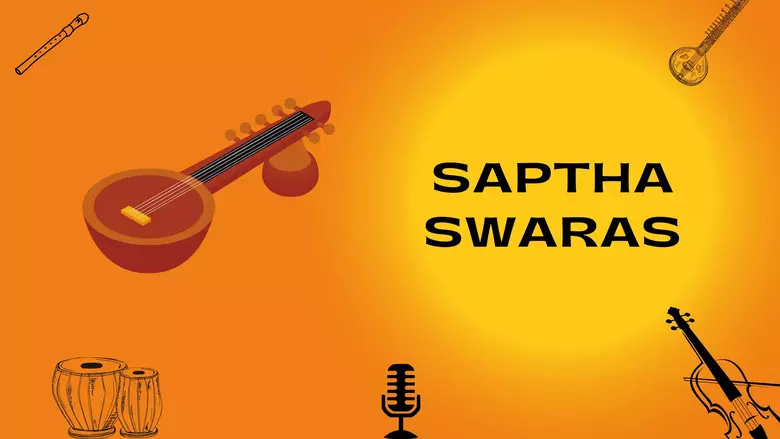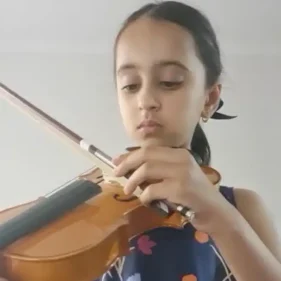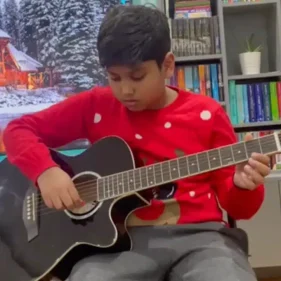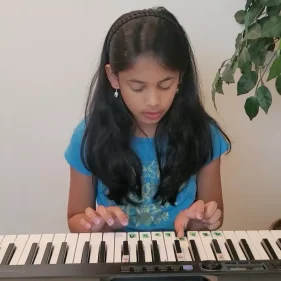Saptha Swaras are the seven swaras, or notes, in Carnatic music lessons. These seven basic notes create the backbone of classical Indian music. Each note has a unique sound and flavor, and understanding their properties is essential for creating beautiful melodies. These notes, when sung correctly, can produce a mesmerizing effect on the listener.
Carnatic sangeetham notes, the ‘saptha swara’ scale consists of seven notes: Shadjam, Rishabham, Gandharam, Madhyamam, Panchamam, Dhaivatham, and Nishadham. Each note has a unique sound and flavor that contributes to the overall beauty of Carnatic music.
Sapthaswarangal: A Complete Guide
As we mentioned before, saptha swaras are the foundation of Carnatic music. Understanding their properties is essential for creating beautiful melodies. Each note has a unique sound to create a certain mood or feeling in a piece of music. For example, the note shadjam creates an energetic or lively mood, while the note rishabham can create a more soothing or peaceful atmosphere.
Once you have a basic understanding of the saptha swaras, you can begin experimenting with different combinations of notes to create your unique melodies. There are endless possibilities for creating saptha swara-based compositions, so don’t be afraid to experiment and explore! This article will discuss the saptha swaras in detail and learn how to sing them correctly.
Origin Of Saptha Swaras
There is no clear-cut evidence about the origin of saptha swaras. They are thought to have evolved through time rather than being the work of a single person or civilization. The Sama Veda, one of Hinduism’s earliest holy books, makes the first mention of swaras. There are the “seven tones of the scale,” according to the Sama Veda. In Bharata Muni’s Natya Shastra, a treatise on performing arts, they were also mentioned.
Purandara Dasa, a Carnatic music composer, further refined the saptha swaras. He created the first swaras scale, consisting of the seven notes: Sa, Ri, Ga, Ma, Pa, Dha, and Ni. Purandara Dasa is also responsible for popularizing these swaras in Carnatic music. He composed many songs and exercises that helped musicians learn how to use saptha swaras in their music.
The sound of animals and birds has given rise to swaras. Shadja, pronounced Sa, is thought to have come from the peacock’s call. At the same time, Rishabha, which is Ri, is believed to have originated from the sound of a bull. Gandhara, which is Ga, is believed to have originated from the sound of a goat, while Madhyama, which is Ma, is believed to have originated from the sound of a Heron. Panchama, which is Pa, is believed to have originated from the sound of a cuckoo, while Dhaivata, which is Dha, is believed to have originated from a horse. Nishada, which is Ni, is believed to have originated from the sound of an elephant. These symbolic beginnings are not only intriguing, but they also serve as the foundation for teaching sapta swaragalu in Kannada music classes, where cultural comparisons encourage easier understanding.
7 Saptha Swaras In Carnatic Music
These seven saptha swaras names, are not only musical elements but also carriers of emotional expression in classical music.
Shadja (SA)
Shadja is the first saptha swaras in classical music. The extended form of Sa is Shadja. All the other swaras are based on the pitch of Shadja. Of all the swaras in carnatic music, this one becomes the tonic of any scale or a raag.
Rishabha (RI)
Rishabha is the second note of Sapthaswarangal. It is placed after the tonic (Sa)and has three different variations such as Shuddha Ri, Chatusruthi Ri and Shatsruti Ri.

Did you know?
Ri, one of the seven swaras in carnatic music, is often associated with creating a peaceful or auspicious atmosphere.
Gandhara (GA)
The third swar in music is Gandhar (Ga). Ga lies a whole step above Ri and plays a vital role in defining a raag. Shuddha Ri, Chatusruthi Ri and Shatsruti Ri are the three variations in the pitches of Gandhar. This sapta swara adds a wide range of colours to different raags.
Madhyama (MA)
The fourth one in saptha swaralu in music is Madhyama placed above Ga. Madhayma is usually one of the crucial swaras in sapta swaras used for shaping the tonal structure of a particular raag. Ma also two variation in pitches resulting in the origins of Shuddha Madhyama and Prati Madhayma.
Panchama (PA)
Panchama (Pa), just like Shadaja, is a constant pitch with no variations. It’s the fifth swara in the sapthaswarangal in music. It lies a whole step above madhyama and a whole step below dhaivat. Pa is very prominent in shaping the flow of any raag..
Dhavita (DHA)
The sixth one in saptha swaras in music is Dhaivat placed above Pa. Dhaivat is usually one of the crucial swaras in Sapta swaras in carnatic music used for determining the emotional expression of any raag. Dha also has two variations in pitches resulting in the origins of Shuddha Dhaivatam and Chathusruti Dhaivatam.
Nishada (NI)
Nishada is the seventh note of Sapthaswarangal. It is placed before the tonic (Sa) and has two different variations such as Kaisiki Ni and Kakali Ni.
All these swar in music are the foundational sounds that form a scale or ragas.
How To Sing Saptha Swaras Correctly?
Different people may have different opinions on the best way to sing saptha swaras correctly. However, here are some tips that may help:
- 1. Make sure you are familiar with the notes and their respective octaves before you start singing saptha swaras.
- 2. Practice the notes regularly to train your voice to reach them accurately and without strain.
- 3. When singing swaras, always aim for a clean and clear sound without excessive vibrato or ornamentation.
- 4. Be mindful of your breathing and ensure that you breathe correctly throughout each note.
- 5. Listen to recordings of other singers who have skills in singing swaras and imitate their techniques.
- 6. Music training from a young age will be an advantage when trying to sing swaras correctly.
- 7. With regular practice and guidance from a skilled teacher, it is possible to sing swaras perfectly.
What are the 7 Swaras in Indian Music?
By following these tips, you should be able to sing saptha swaras correctly in no time! Do you have any other tips for singing swaras? Please share with us in the comments section below.
| Swaras Name | Solfa letters | Pronounced as |
| Shadjam | S | Sa |
| Rishabham | R | Ri |
| Gandharam | G | Ga |
| Madhyamam | M | Ma |
| Panchamam | P | Pa |
| Dhaivatham | D | Da |
| Nishadam | N | Ni |
In our ancient Tamil music the Saptha swaras are called Sa- Kural, Ri- Uzhai, Ga- Kaikilai, Ma- Thutham, Pa- Ili, Da- Vilari, Ni- Tharam.
In European music: Sa- Doh, Ri- Ray, Ga- Me, Ma- Fa, Pa- Soh, Da- Lah, Ni- Si, or Te.
Of the above seven swaras, the first and the fifth swaras (Sa- Pa) are fixed notes. They are called Prakrithi Swaras. Remaining five swaras (Ri- Ga- Ma- Da- Ni) consist of two varieties lower and higher in other words Komal and Theevra. They are called Vikrithi Swaras. By the varieties in Vikrithi swaras, and with the two constant notes in Prakrithi Swaras, we have in all 10+2 = 12 notes (Sruthis or swaras) as follows.
| Swaras Name | Komal or Theevra | Equivalent in European Music |
| Shadjam | S | C |
| Suddha Rishabham | R1- Ko | D- Flat |
| Chathu Sruthi Rishabham or Suddha Gandharam | R2- THEE | D |
| Sadharana Gandharam or Shat Sruthi Rishabham | G1- Ko | E- Flat |
| Anthara Gandharam | G2- THEE | E |
| Suddha Madhyamam | M1- Ko | F |
| Prathi Madhyamam | M2- THEE | F- Sharp |
| Panchamam | P | G |
| Suddha Dhaivatham | D1- Ko | A-Flat |
| Chathu Sruthi Dhaivatham or Suddha Nishadam | D2- THEE | A |
| Kaisiki Nishadam or Shat Sruthi Dhaivatham | N1- Ko | B-Flat |
| Kakali Nishadam | N2- THEE | B |
| Chathu Sruthi Rishabham & Suddha Gandharam | Same Note | |
| Sadharana Gandharam & Shat Sruthi Rishabham | Same Note | |
| Chathu Sruthi Dhaivathamam & Suddha Nishadam | Same Note | |
| Kaisiki Nishadam & Shat Sruthi Dhaivathamam | Same Note |
What is the difference between Hindustani and Carnatic swaras?
| ASPECT | HINDUSTANI | CARNATIC |
| System | Uses sargams(Sa, re, ga, ma, pa, dha, ni) | Uses swaras(Sa, ri, ga, ma, pa, dha, ni) |
| Types of variations | shudh(natural), komal(flat),(Tivra) | Shuddha, Chatusrithi, sadharna,satsruthi, kakali, |
| structure | More flexible scale structure | Fixed structures based on specific raags |
| approach | Focuses on raag improvisation | Focused on structured melodies with fixed compositions |
| Notes usage in raags | Are often altered depending on raag and samay | Are often defined precisely with little variations |
RAGA: Raga is the combination of appropriate swaras in the Arohana and Avarohana.
Arohana – The ascending order of the swaras.
Avarohana – The descending order of the swaras.
Sthayis
There are five sthayis (Octaves) namely 1. Anumandra sthayi, 2. Mandra shtayi, 3. Madhya sthayi, 4. Thara sthayi, 5. Athi Thara sthayi.
- Anumandra sthayi – Two dots below the swara – S
- Mandra sthayi – One dot below the swara – S
- Madhya sthayi – Swara without dot – S
- Thara sthayi – One dot above the swara – S
- Ath Thara sthayi – Two dots above the swara – S
The Common Symbols Used In Carnatic Music
, … Indicates one Akshara Kala.
,, or ; … Indicates two Akshara Kala.
| … Indicates the splitting of the laghu and dhrutham.
|| … Indicates the ending of Thala Avartham
– … If this symbol comes near the swaras, it will indicate splitting the group of swaras. If the same symbol appears along with the sahithyas it indicate the continuation.
Note
The swaras are used in capital letters and one akshara kala for each swaras. Commas (,) are used with the swaras for additional akshara kalas. Example:
S or , – One akshara kala
S , – Two akshara Kalas
S , , – Three akshara Kalas
S , , , – Four akshara Kalas,
Conclusion
Although saptha swaras are just seven notes, they hold great power when used correctly in music. If you are interested in learning more about this ancient system or want to consult with a professional music institute on how to use sapta swaras in your compositions.
FAQs
What are the 7 notes of raga?
Sa, re, ga, ma, pa, dha, ni, sa are the 7 notes of raga.
What is the full form of 7 swaras?
Sa- Shadaja, Re-rishab, Ga-gandhar, Ma-madhyama, Pa-pancham,Dha-Dhaivat, Ni-Nishad.
What is the origin of sapta swaras?
The origin of sapta swaras dates back to vedic times.
Who invented saptaswara?
Sapta swaras origin is attributed to the sage barata.
Which are the swaras in carnatic music ?
Sa, re, ga, ma, pa, dha, ni are the swaras in carnatic music.
How to learn saptha swaras?
To learn saptha swaras, start by practicing the pitches of Sa, re, ga, ma, pa, dha, ni via class, online tutorials etc.
Related Blog: Lesson 6 – Saptha Thala Alankaras and Lesson 9 – Swarajathis






























